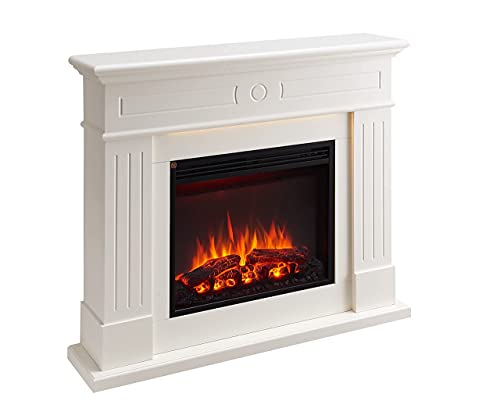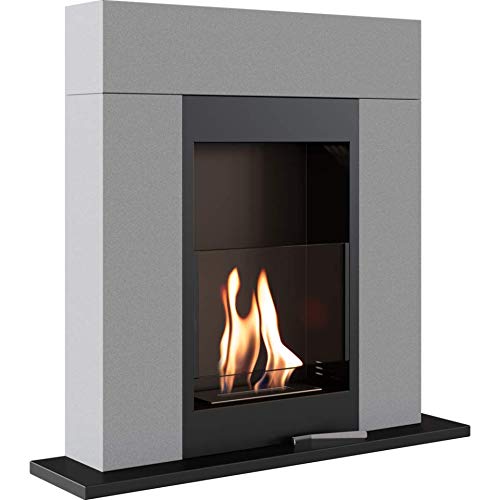Fireplace: What Nobody Is Talking About
페이지 정보
작성자 Darin Harwell 작성일23-12-15 23:57 조회4회 댓글0건관련링크
본문
 What Are Fireplace Accessories?
What Are Fireplace Accessories? Many homes have fireplaces that provide warmth and comfort all day long and into the night long. They also provide beauty and value to the house.
Many homes have fireplaces that provide warmth and comfort all day long and into the night long. They also provide beauty and value to the house.Homeowners can take on most of these tasks regardless of whether your fireplace uk needs an overhaul or just a few basic repairs. Certain tasks that require gas are best left to the professionals.
The Hearth
The hearth is a non-combustible surface that covers a fireplace store or wood-burning stove. It could be a complete elevated area or simply the foundation on which the fireplace sits. The term "hearth" is commonly used to describe the entirety of the fireplace including the firebox, the raised floor and mantel as well as the chimney. It is crucial to remember that there are specific fire safety regulations concerning the construction of the fireplace and its accessories. You should consult your local governing authority for more information.
Hearths are usually constructed of brick, stone or cement. They can be a focal point of any room. They are designed to create a barrier between the fireplace and the flooring and protect against accidental fires caused by stray embers or logs. They can also be used to store fireplace tools, wood, and other items.
Archaeological research points to the importance of hearths as a key to early human existence. It is widely believed that they provided food, protection, light and warmth.
A hearth could be a source of serious health issues when it isn't properly maintained. Smoke exposure raises nitrogen levels in the blood which blocks red blood cells from delivering oxygen to the tissues (methemoglobinemia). At high concentrations it may cause nausea, dizziness and loss of consciousness.
Hearths were once made of rock, but are now more commonly made from brick or concrete. They are available in many shapes and sizes. Some cooking cheap fireplaces have hearths that are able to cover the entire wall and others are smaller and purely decorative elements that cover the opening of the fireplace. The material used in a hearth can have a significant impact on its appearance, cost and heat resistance.
The Surround
A fireplace surround, also known as a "mantel", is the frame over the hearth that adds to the ambiance of a room. In addition to its aesthetic value it is also a functional element since it shields flammable materials from the fireplace and deflects heat away from the room. It also serves as a shelf for household items such as mirrors or paintings.
Depending on the type of fireplace, there are various materials that can be used for the surround. Some surrounds are non-combustible, and others must be in compliance with federal and local fire codes in relation to clearance distances from combustible objects.
Some of the most popular choices for surrounds include concrete, brick and fireplace in my area stone. Certain stone surrounds feature decorative features like bevels and bolection moulding. The stone surrounds could include plinths or cornices. These features can give a home an elegant appearance that is in harmony with the style.
Another option is to use plaster. This material is made from a mixture of sand, cement and water and can be shaped to match any architectural style. A plaster surround, for instance, can complement a Mission style home.
Tile is the last choice for a surround. Tiles come in a variety of colors and designs. It can be used as a decorative element to the surround, or spread across the entire wall to create an impressive focal feature. Tile is a great option for homes that have a contemporary or modern style.
The surround is among the first things that guests see when they enter a living space. It is crucial to choose an item that will set the mood for your space and to add value to your home.
The Firebox
The firebox is the area behind a fireplace's opening where the fire can be constructed and maintained. The firebox is typically enclosed by a chimney, allowing smoke to escape. The majority of these traditional structures burn wood but some also burn gas such as natural gas or propane.
The firebox is the place where combustion occurs and must be maintained properly for safety and effectiveness. The firebox consists of a number of important parts. These include the grate and the fire poker and the air damper.
It is crucial to regularly clean your fireplace. This includes maintaining the firebox in good shape and the liner. The inside of the fireplace will be soiled by dust and soot due to its continuous exposure to high temperatures. You can employ a scraper or wirebrush to remove the soot and ash that has been clogged up.
For durability and long-term longevity, it's a good idea to line the inside of your fireplace with steel slag. These types of metals can resist corrosion and won't be rusty. They will also provide a more uniform heat distribution and last longer.
Additionally, you can add some visual interest to your fireplace In My area by adding decorative fire logs or lava rocks. Some people opt for modern-looking decorative glass instead. Make certain that whatever you're using to make your fireplace is UL certified for safety. This includes not only the fireplace itself but also the accessories and decorations you're adding to it.
The Burner
Burners are a popular method to add warmth and style to any room. These fireplace accessories are available in many different sizes and shapes and shapes, making it easy to find one that fits your home. Some are even equipped with remotes, which means you can control the flame from anywhere in the room. They are also safe to use, making them an excellent choice for outdoor and indoor areas.
There are a variety of burners, each with their own pros and cons. Some are more expensive, however they all have a variety of advantages. Some are safer than others, and a few can be used without or with chimneys. Whatever kind of burner you select be sure to follow the guidelines that are in the manual. This will ensure the burner is installed correctly and in compliance with all state and local laws.
The burning of wood is a traditional way to enjoy your fireplace, but it's not always efficient. The smoke and soot generated by burning wood can be dangerous to your family members and yourself. Ethanol burners release water vapor, and very little CO2, making them more sustainable.
A fireplace can also be helpful in the case of a power outage. In winter, a lot of snow and ice can accumulate on trees, which could cause them to fall and slam down power lines hanging from the ceiling. You can use your fireplace to cook and keep warm in the event that the electricity is out in your home. This is a great solution for homeowners who are prepared for the unexpected.
The Flu
The flue is an internal tunnel inside the chimney that carries smoke and gases from your fireplace to your home. It is an essential element for a safe, efficient fire. A flue creates an updraft that draws air through the fire, allowing fuel to fully burn and reducing smoke.
The draft action of the flue keeps the hot gases emitted by the fire from venting into your home. Instead they are taken out to cool. This controlled venting that stops carbon monoxide poisoning.
Check your chimney regularly for blockages and leaks. The flue pipe (a steel tube or duct running through the middle of the chimney) must be cleaned with special cleaning chemicals and equipment. This includes a metal brush and the use of a drill with a masonry bit as well as masking tape and an utility knife to remove any creosote or soot that has accumulated on the flue's walls. pipe.
The flue should be kept closed when you aren't using your fireplace can help keep conditioned indoor air from escaping. This also stops wind or rain from entering the fireplace and causing damage to your wood stove or gas furnace.
The damper, which is located at the bottom of the flue pipe or flue tiles and at the top of the fireplace, can be shut or opened via a latch or handle. The damper is designed to keep a fireplace's flue open when there is a fire burning. However it should be closed when the fireplace is not in use. This will save you money on your energy bills.
댓글목록
등록된 댓글이 없습니다.

